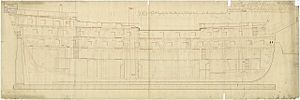HMS Royal Oak (1809) facts for kids
class="infobox " style="float: right; clear: right; width: 315px; border-spacing: 2px; text-align: left; font-size: 90%;"
| colspan="2" style="text-align: center; font-size: 90%; line-height: 1.5em;" |
|}
HMS Royal Oak was a large warship of the Royal Navy. It was known as a 74-gun third rate ship of the line. This means it was a powerful sailing ship with 74 cannons on its decks. The ship was built at Dudman's yard in Deptford Wharf and launched on March 4, 1809. Its first captain was Pulteney Malcolm.
Contents
| History | |
|---|---|
| Name | HMS Royal Oak |
| Builder | Dudman, Deptford Wharf |
| Laid down | December 1805 |
| Launched | 4 March 1809 |
| Fate | Broken up, 1850 |
| General characteristics | |
| Class and type | Fame-class ship of the line |
| Tons burthen | 1759 (bm) |
| Length | 175 ft (53 m) (gundeck) |
| Beam | 47 ft 6 in (14.48 m) |
| Depth of hold | 20 ft 6 in (6.25 m) |
| Propulsion | Sails |
| Sail plan | Full-rigged ship |
| Complement | 650 officers and men (inc. 60-80 marines) |
| Armament |
|
Life as a Warship
HMS Royal Oak served during an important time in history. This included the Napoleonic Wars and the War of 1812.
Serving in the Napoleonic Wars
In 1812, Captain Thomas George Shortland commanded Royal Oak. He was later replaced by Captain Edward Dix in 1813. During this time, the ship was the flagship for Rear-Admiral Lord Amelius Beauclerk. A flagship is where the admiral, a very senior naval officer, stays. Royal Oak was stationed near the Texel, an island in the Netherlands.
Adventures in the War of 1812
Royal Oak played a part in the War of 1812 between the United States and Great Britain. In December 1813, the ship helped capture an American vessel called Maria Antoinette. The crew of Royal Oak shared in the rewards from this capture.
Journey to North America
On June 1, 1814, Rear-Admiral Pulteney Malcolm returned to Royal Oak. He made it his flagship again. The ship then sailed to North America with soldiers led by Brigadier-General Robert Ross. Admiral Malcolm helped Sir Alexander Cochrane with a mission up the Chesapeake Bay. He managed how the troops got on and off the ships during attacks on Washington and Baltimore.
Sadly, General Ross was killed on September 12, 1814, in Baltimore, Maryland. Royal Oak carried his body to Halifax, Nova Scotia. He was buried there on September 29, 1814.
The Battle of Lake Borgne
In December 1814, Royal Oak joined a large fleet. This fleet, led by Admiral Cochrane, was preparing to attack New Orleans. Before the main attack, the ship's smaller boats took part in the Battle of Lake Borgne.
On December 8, 1814, American gunboats fired at some British ships. These ships were Sophie, Armide, and Seahorse. They were sailing near small islands between Mobile and Lake Borgne.
Between December 12 and 15, 1814, Captain Lockyer of Sophie led a group of about 50 small boats. These boats were from the main fleet, including the powerful 74-gun ships Royal Oak and Tonnant. Other ships like Armide, Seahorse, Manly, and Meteor also sent boats.
Captain Lockyer divided the boats into three groups. After rowing for 36 hours, the British boats found the Americans. On December 13, 1814, they attacked the American schooner USS Sea Horse. The next morning, December 14, a quick and fierce battle took place.
The British captured all the American boats. This included the tender USS Alligator and five gunboats. The British lost 17 men and 77 were wounded. Royal Oak had only one sailor wounded in this battle. Later, in 1847, a special medal clasp was given to the survivors of this boat service.
Support for New Orleans Attack
Sixty Royal Marines from Royal Oak went ashore to help with the attack on New Orleans. One of these marines was killed on January 8, 1815. This happened when a group of marines, sailors, and soldiers attacked American positions. This group was led by Colonel William Thornton. The naval part of the group was led by Commander Rowland Money, who was badly wounded.
The End of Service
From 1825, Royal Oak was used for harbour service. This means it stayed in port and was not used for active sailing. In 1850, the ship was finally taken apart.


